 W
W3D printing, or additive manufacturing, is the construction of a three-dimensional object from a CAD model or a digital 3D model. The term "3D printing" can refer to a variety of processes in which material is deposited, joined or solidified under computer control to create a three-dimensional object, with material being added together, typically layer by layer.
 W
WThe Atari 1020 was a four-colour computer plotter sold by Atari, Inc. for the Atari 8-bit home computers.
 W
WA barcode printer is a computer peripheral for printing barcode labels or tags that can be attached to, or printed directly on, physical objects. Barcode printers are commonly used to label cartons before shipment, or to label retail items with UPCs or EANs.
 W
WThe CandyFab is a method of producing physical objects out of a computer representation of the structure. It differs from some other 3D printing methods in the following aspects:It is optimized for relatively large pieces using low to medium print resolution. To reduce the hazards of working with large amounts of media, non-toxic materials are used. The prototype CandyFab 4000 unit uses granulated sugar as its print medium, giving rise to its name, but other materials with low melting temperatures and low toxicities are still under consideration. It uses low cost parts and construction to make it easier for others to design or build their own, with plans available as open source.
 W
WThis article is about the various external peripherals of the Commodore 64 home computer. Due to the backwards compatibility of the Commodore 128, most peripherals will work on that system, as well. There's some compatibility with the VIC-20 and PET too.
 W
WContinuous stationery (UK) or continuous form paper (US) is paper which is designed for use with dot-matrix and line printers with appropriate paper-feed mechanisms. Other names include fan-fold paper, sprocket-feed paper, burst paper, lineflow, tractor-feed paper, and pin-feed paper. It can be single-ply or multi-ply, often described as multipart stationery or forms. Continuous stationery is often used when the final print medium is less critical in terms of the appearance at the edges, and when continuously connected individual sheets are not inconvenient for the application. Individual sheets can be separated at the perforation, and sheets also have edges with punched holes, which also can be removed at the perforation.
 W
WDaisy wheel printing is an impact printing technology invented in 1970 by Dr Andrew Gabor at Diablo Data Systems. It uses interchangeable pre-formed type elements, each with typically 96 glyphs, to generate high-quality output comparable to premium typewriters such as the IBM Selectric, but two to three times faster. Daisy wheel printing was used in electronic typewriters, word processors and computers from 1972. The daisy wheel is considered to be so named because of its resemblance to the daisy flower.
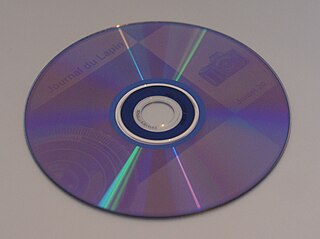 W
WDiscT@2 is a method of writing text and graphics to the data side of a CD-R or DVD disc first introduced by Yamaha in 2002. While often compared with the later LabelFlash and LightScribe technologies, which also offered users consumer-grade computerized disc labeling, DiscT@2 is different in that it required no proprietary media and wrote the graphics to the data side of the disc.
 W
WDye-sublimation printing is a computer printing technique which uses heat to transfer dye onto materials such as a plastic, card, paper, or fabric. The sublimation name was first applied because the dye was considered to make the transition between the solid and gas states without going through a liquid stage. This understanding of the process was later shown to be incorrect, as there is some liquefying of the dye. Since then, the proper name for the process has become known as dye-diffusion, though this technically-correct term has not supplanted the original name. Many consumer and professional dye-sublimation printers are designed and used for producing photographic prints, ID cards, clothing, and more.
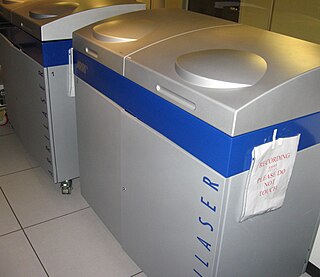 W
WA film recorder is a graphical output device for transferring images to photographic film from a digital source. In a typical film recorder, an image is passed from a host computer to a mechanism to expose film through a variety of methods, historically by direct photography of a high-resolution cathode ray tube (CRT) display. The exposed film can then be developed using conventional developing techniques, and displayed with a slide or motion picture projector. The use of film recorders predates the current use of digital projectors, which eliminate the time and cost involved in the intermediate step of transferring computer images to film stock, instead directly displaying the image signal from a computer. Motion picture film scanners are the opposite of film recorders, copying content from film stock to a computer system. Film recorders can be thought of as modern versions of Kinescopes.
 W
WThe Game Boy Printer, known as the Pocket Printer in Japan, is a thermal printer accessory released by Nintendo in 1998, which ceased being manufactured in early 2003. The Game Boy Printer is compatible with all the Game Boy systems except the Game Boy Micro and is designed to be used in conjunction with the Game Boy Camera. It also prints images from compatible late-generation Game Boy and Game Boy Color games. It runs on six AA batteries and uses a proprietary 38mm wide thermal paper with adhesive backing, originally sold in white, red, yellow and blue colors. In Japan, a bright yellow Pokémon version of the Game Boy Printer was released, featuring a feed button in the style of a Poké Ball.
 W
WGiclée is a neologism coined in 1991 by printmaker Jack Duganne for fine art digital prints made on inkjet printers. The name originally applied to fine art prints created on a modified Iris printer in a process invented in the late 1980s. It has since been used loosely to mean any fine-art, most of the time archival, printed by inkjet. It is often used by artists, galleries, and print shops to suggest high quality printing, but since it is an unregulated word it has no associated warranty of quality.
 W
WThe IBM 3800 is a discontinued continuous forms laser printer designed and manufactured by IBM. It is significant as a product because it was both the first laser printer manufactured by IBM, and the first commercially available continuous forms laser printer.
 W
WThe IBM 6670 Information Distributor (6670-001), a combination laser printer and photocopier, was announced on February 14, 1979 as part of Office System/6. Its feature set included two-sided printing.
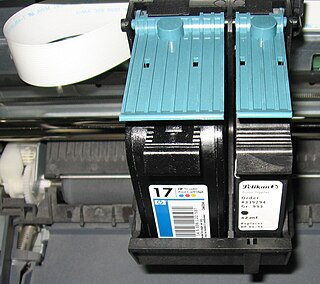 W
WAn ink cartridge or inkjet cartridge is a component of an inkjet printer that contains the ink that is deposited onto paper during printing.
 W
WAn inkjet spittoon is a component in electronic inkjet printers. Inkjet printers commonly experience a problem of drying out which blocks the flow of ink. To restore flow, it is necessary to clean the inkjet head by spraying excess ink through all the jets to reapply moisture and unblock the adjacent clogged jets. The excess ink used for cleaning needs to be collected somewhere to avoid creating a mess below the printer, so inkjet printers have a "spittoon" hidden inside to collect this ink.
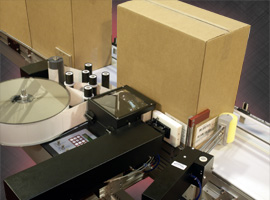 W
WLabel printer applicators are basic robots that automatically print and apply pressure-sensitive labels to various products. Some types of labeling include shipping labeling, content labeling, graphic images, and labeling to comply with specific standards such as those of GS1 and Universal Product Code U.P.C. A pressure-sensitive label consists of a label substrate and adhesive. First developed in the late 1970s, today there are over 70 manufacturers of these types of machines worldwide.
 W
WLabelflash is a technology which allows users to burn custom designs or images onto proprietary DVD media first announced in October 2005 as a collaboration between Yamaha and Fujifilm. While Yamaha developed the optical drives, Fujifilm manufactured the proprietary Labelflash optical discs. NEC manufactured the first Labelflash compatible drive, the ND4551, which was released in December 2005.
 W
WAn LED printer is a type of computer printer similar to a laser printer. Such a printer uses a light-emitting diode (LED) array as a light source in the printhead instead of the laser used in laser printers and, more generally, in the xerography process. The LED bar pulse-flashes across the entire page width and creates the image on the print drum or belt as it moves past.
 W
WLightScribe is an optical disc recording technology that was created by the Hewlett-Packard Company. It uses specially coated recordable CD and DVD media to produce laser-etched labels with text or graphics, as opposed to stick-on labels and printable discs. Although HP is no longer developing the technology, it is still maintained and supported by a number of independent enthusiasts.
 W
WMicroDry is a computer printing system developed by the ALPS corporation of Japan. It is a wax/resin-transfer system using individual colored thermal ribbon cartridges, and can print in process color using cyan, magenta, yellow, and black cartridges, as well as such spot-color cartridges as white, metallic silver, and metallic gold, on a wide variety of paper and transparency stock. Certain MicroDry printers can also operate in dye sublimation mode, using special cartridges and paper. ALPS licensed the technology to Citizen and to Okidata. Alps also produced the actual printer hardware and ink ribbon cartridges for those companies.
 W
WAn MFP, multi-functional, all-in-one (AIO), or multi-function device (MFD), is an office machine which incorporates the functionality of multiple devices in one, so as to have a smaller footprint in a home or small business setting, or to provide centralized document management/distribution/production in a large-office setting. A typical MFP may act as a combination of some or all of the following devices: email, fax, photocopier, printer, scanner.
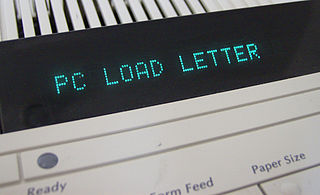 W
WPC LOAD LETTER is a printer error message that has entered popular culture as a technology meme referring to a confusing or inappropriate error message. The error message's vagueness was mocked in the 1999 comedy film Office Space.
 W
WIn computing, a printer is a peripheral device which makes a persistent representation of graphics or text, usually on paper. While most output is human-readable, bar code printers are an example of an expanded use for printers. The different types of printers include 3D printer, inkjet printer, laser printer, thermal printer, etc.
 W
WThe Printer Working Group (PWG) is a consortium of printer and network manufacturers with the charter to develop standards that make printers, operating systems, and applications work better.
 W
WSolid ink is one technology used in computer printers and multifunction devices. Although originally credited with creation by Tektronix in 1986 it was also credited to Howtek, Inc in 1985. Howtek Solid inks could print millions of colors by subtractive color deposition (layering). The Pixelmaster, a Howtek product, printed with 32 single nozzle inkjets mounted in a rotating reservoir with 8 nozzles per color. It was designed to print on standard sheet paper in 4 minutes with alpha-numeric or images. The Pixelmaster was manufactured by Juki Corporation and sold by Howtek, Inc., Hudson, NH.
 W
WThermal printing is a digital printing process which produces a printed image by selectively heating coated thermochromic paper, or thermal paper as it is commonly known, when the paper passes over the thermal print head. The coating turns black in the areas where it is heated, producing an image. Two-color direct thermal printers can print both black and an additional color by applying heat at two different temperatures.
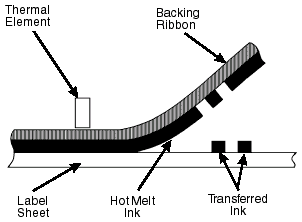 W
WThermal-transfer printing is a digital printing method in which material is applied to paper by melting a coating of ribbon so that it stays glued to the material on which the print is applied. It contrasts with direct thermal printing, where no ribbon is present in the process.
 W
WTiled printing is a method that computer programs use to enable users to print images larger than a standard page, popularized by a program called The Rasterbator. A tiled printing program overlays a grid on the printed image in which each cell is the size of a printed page and then prints each tile. A person can then arrange the tiles to reconstruct the full image.
 W
WToner is a powder mixture used in laser printers and photocopiers to form the printed text and images on the paper, in general through a toner cartridge. Mostly granulated plastic, early mixtures only added carbon powder and iron oxide, however, mixtures have since been developed containing polypropylene, fumed silica, and various minerals for triboelectrification. Toner using plant-derived plastic also exists as an alternative to petroleum plastic. Toner particles are melted by the heat of the fuser, and are thus bonded to the paper.
 W
WA toner cartridge, also called laser toner, is the consumable component of a laser printer. Toner cartridges contain toner powder, a fine, dry mixture of plastic particles, carbon, and black or other coloring agents that make the actual image on the paper. The toner is transferred to paper via an electrostatically charged drum unit, and fused onto the paper by heated rollers during the printing process. It will not stain like ink cartridges, but it can get messy if handled improperly.
 W
WToner refilling is the practice of refilling empty laser printer toner cartridges with new toner powder. This enables the cartridge to be reused, saving the cost of a complete new cartridge and the impact of the waste and disposal of the old one.
 W
WIn computing a virtual printer is a simulated device whose user interface and API resemble that of a printer driver, but which is not connected with a physical computer printer.